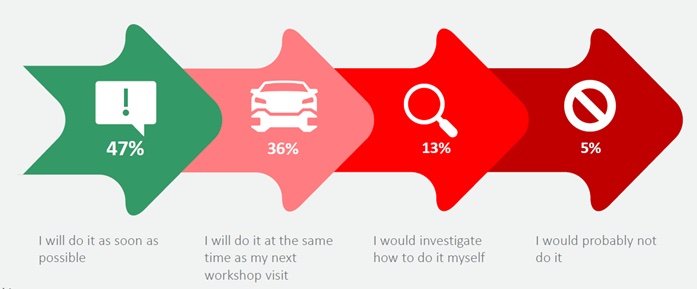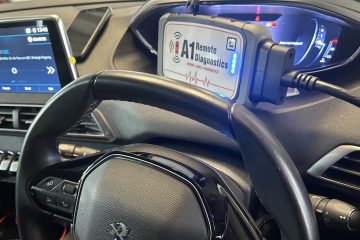A new report from the Institute of the Motor Industry (IMI) warns that less than half of motorists see ADAS calibration as a vital job.
The number of vehicles featuring ADAS is increasing every year. The IMI estimates that by the end of 2023, at least one in ten cars will feature Level 2 autonomy, growing to almost half of the car parc by 2030. These technologically advanced vehicles make roads safer for all users.

However, the IMI report, Understanding the Knowledge Gap, found that while 86% of more than 1,000 drivers said they have at least one ADAS feature in their vehicle, just 18% understand what it is and could correctly identify it.
ADAS misinformation is worrying
The report also finds that 39% of drivers incorrectly believe that ADAS calibration is carried out as part of the MOT, meaning many drivers will leave their systems untouched. If calibration is required, this false knowledge could prove to be dangerous.
Another worrying statistic is that only 16% of drivers were confident that ADAS on their vehicle had been recalibrated after repairs or maintenance, suggesting that garages are not making drivers aware of the full services they offer when completing work.
“It is extremely worrying that so few drivers fully understand their vehicle or appreciate the importance of maintaining its systems,” explained Steve Nash, CEO of the IMI.“ADAS technology is not checked as a matter of course at the annual MOT and it is the motorist’s responsibility to ensure their vehicle is properly maintained. If a motorist is not aware of ADAS technology, how can they be certain it is being maintained properly?
“Motorists need to be as diligent as possible about vehicle safety, getting any ADAS alerts reviewed in a timely manner by a technician qualified and fully certified to work on the technology.
“Unfortunately, with the current shortage of ADAS qualified technicians, finding someone locally who can do the job proficiently may be more time consuming than expected. But it is imperative that drivers are nottempted to take a shortcut and take their car to someone who is not ADAS qualified. If a system such as lane departure warnings or adaptive cruise control fail at high speed on a motorway, the potential consequences do not bear thinking about.”
Training and understanding critical
ADAS technologies that are not properly maintained and calibrated can deliver inaccurate readings or false alerts and could even malfunction and compromise the vehicle’s safety. The lack of knowledge could also put motorists at a disadvantage when selecting a garage for vehicle repairs, which could result in a vehicle not being properly recalibrated for all its ADAS features. The IMI believes it is not just technicians that need to understand ADAS; sales and front of house staff need to understand the technology otherwise they could be feeding consumer ignorance.

ADAS calibration is essential for ensuring the safety of drivers, passengers, and other road users. These systems rely on accurate measurements and data to operate effectively, and even slight deviations from the recommended specifications can compromise their performance. Improper calibration can result in false alerts or failure to detect hazards, leading to accidents, injuries, and even fatalities.
Nicholas Lyes, Director of Policy and Standards at IAM RoadSmart, added: “ADAS technology has the potential to improve road safety, but only if used correctly. If it is not, not least without a full understanding of what the systems are and are not capable of, it can have the opposite effect, with potentially worrying consequences for all road users.
“IAM RoadSmart believes ADAS training can have a huge part in getting consumers familiar with technology that will save their lives. As the UK’s leading road safety charity, we would be more than happy to work with dealerships to help promote these systems as they begin to be supplied as standard on an increasing number of vehicles.”
Editor’s comment
The number of cars with ADAS is increasing, but these systems are marketed by car manufacturers as ‘features’ rather than technology advances. They are either comfort additions, or safety packs, but not critical pieces of technology that could go wrong if not properly maintained.
Many drivers will not understand ADAS, simply because the term is not used in the sales pitch. The car will not come with ADAS, it will come with adaptive cruise control, lane-keep assist, blind-spot monitoring, automatic emergency braking, parking sensors, and so forth. They are a convenience, and the technology behind them is often too complicated to explain.
So once again, the burden of education falls on the aftermarket. It is up to garages to explain ADAS, how it needs to be calibrated, how improper calibration can lead to dangerous situations, and how it will benefit the driver. Of course, these discussions take time, but doing it can lead to improved customer relationships and, of course, increased work. If dealerships and manufacturers cannot be bothered to explain at the point of sale, the aftermarket has to pick up the pieces. It seems we understand cars much more than those who sell them.
That is, of course, if technicians are properly trained in ADAS calibration and system repair, something that is part of the industry’s ongoing skills shortage. But stories such as this should serve to highlight the need for training, or to take on technicians and apprentices who can and will learn. And for those who are putting it off because you will never see the technology in the workshop, or that you do not understand the systems in the first place, it will be your business that will suffer. ADAS is not the future, it is now, and there is a desperate need for knowledge.




You must be logged in to post a comment.